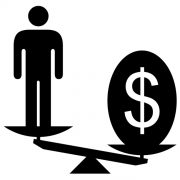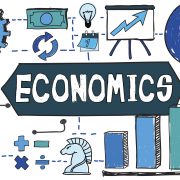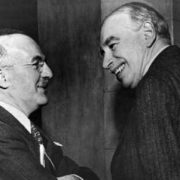Economic Growth Precedes And Enhances Economic Equality
Amity Shlaes is a substantial intellectual whose original research has led her to a differentiated point of view, expressed in a distinctive style. Her book, Coolidge and The Forgotten Man: A New History of the Great Depression revised history rethinking the value of government intervention in the marketplace. She now chairs the board of the Calvin Coolidge Presidential Foundation and serves as presidential scholar at the King’s College.
The current article is a long one by Center For Individual norms, but super-valuable and super-instructive because of the analysis of the trade-offs between economic growth and economic equality. The conclusion: we can have both, but they have to be in balance and in the right order. It is growth that brings equality and makes it possible.
________________________________________________________________________________
Free marketeers may sometimes win elections, but they are not winning U.S. history. In recent years, the consensus regarding the American past has slipped leftward, and then leftward again. No longer is American history a story of opportunity, or of military or domestic triumph. Ours has become, rather, a story of wrongs, racial and social. Today, any historical figure who failed at any time to support abolition, or, worse, took the Confederate side in the Civil War, must be expunged from history. Wrongs must be righted, and equality of result enforced.
Economists Seem To Have Forgotten About Free Markets.
The equality campaign spills over into a less obvious field, one that might otherwise provide a useful check upon the nonempirical claims of the humanities: economics. In a discipline that once showcased the power of markets, an axiom is taking hold: equal incomes lead to general prosperity and point toward utopia. Teachers, book review editors, and especially professors withhold any evidence to the contrary. Universities lead the shift, and the population follows. Today, millennials, those born between 1981 and 2000, outnumber baby boomers by the millions, and polls suggest that they support redistribution specifically, and government action generally, more than their predecessors do. A 2014 Reason/Rupe poll found 48 percent of millennials agreeing that government should “do more” to solve problems, whereas 37 percent said that government was doing “too many things.” A full 58 percent of the youngest of millennials, those 18–24 when surveyed, held a “positive” view of socialism, in dramatic contrast with their parents: only 23 percent of those aged 55 to 64 viewed socialism positively.
At least for now, most progressives acknowledge that markets and economic growth are necessary. But progressives in academia contend that growth has proved itself secondary to equality efforts—something to be exploited, rather than appreciated. Not just nationally, but worldwide, policymakers and the press regard the subordination of growth to equality to be a benign practice, as in the recent line in the Indian periodical Mint: a policy aimed at “reducing inequality need not hurt growth.”
The Gini Coefficient: A Flawed Metric.
The redistributionist impulse has brought to the fore metrics such as the Gini coefficient, named after the ur-redistributor, Corrado Gini, an Italian social scientist who developed an early statistical measure of income distribution a century ago. A society where a single plutocrat earns all the income ranks a pure “1” on the Gini scale; one in which all earnings are perfectly equally distributed, the old Scandinavian ideal, scores a “0” by the Gini test. The Gini Index has been renamed or updated numerous times, but the principle remains the same. Income distribution and redistribution seem so crucial to progressives that French economist Thomas Piketty built an international bestseller around it, the wildly lauded Capital.
Through Gini’s lens, we now rank past eras. Decades in which policy endeavored or managed to even out and equalize earnings—the 1930s under Franklin Roosevelt, the 1960s under Lyndon Johnson—score high. Decades where policymakers focused on growth before equality, such as the 1920s, fare poorly. Decades about which social-justice advocates aren’t sure what to say—the 1970s, say—simply drop from the discussion. In the same hierarchy, federal debt moves down as a concern because austerity to reduce debt could hinder redistribution. Lately, advocates of economically progressive history have made taking any position other than theirs a dangerous practice. Academic culture longs to topple the idols of markets, just as it longs to topple statutes of Robert E. Lee.
But progressives have their metrics wrong and their story backward. The geeky Gini metric fails to capture the American economic dynamic: in our country, innovative bursts lead to great wealth, which then moves to the rest of the population. Equality campaigns don’t lead automatically to prosperity; instead, prosperity leads to a higher standard of living and, eventually, in democracies, to greater equality. The late Simon Kuznets, who posited that societies that grow economically eventually become more equal, was right: growth cannot be assumed. Prioritizing equality over markets and growth hurts markets and growth and, most important, the low earners for whom social-justice advocates claim to fight. Government debt matters as well. Those who ring the equality theme so loudly deprive their own constituents, whose goals are usually much more concrete: educational opportunity, homes, better electronics, and, most of all, jobs. Translated into policy, the equality impulse takes our future hostage.
A History Of Growth In America.
Touring American history with an eye on growth, not equality, has become so unusual that doing so almost feels like driving on the wrong side of the road. Nonetheless, a review trip through the decades is useful because the evidence for growth is right there, in our own American past. Four decades, especially, warrant examination: the 1920s, the 1930s, the 1960s, and the 1970s.
The modern American economic story starts with the 1920s, a decade worth dwelling on at some length because of the stunning evidence that it offers of growth’s power. The winners of the 1920 election were two Republicans, Warren G. Harding of Ohio and his vice presidential candidate, Calvin Coolidge of Massachusetts. Confronting these men and, indeed, Congress, was the same pressure to prioritize redistribution that weighs on us today. In the aftermath of World War I, commodity prices had plummeted; farmers could not pay the bills for equipment and land that they’d purchased in better years. The farmers demanded agricultural subsidies from Washington; veterans sought a federal pension, an early version of Social Security. Harding and Coolidge’s 1920 opponent from the Socialist Party, Eugene Victor Debs, won only 3.5 percent of the popular vote. But the dignified Debs, in prison for noncompliance with the wartime draft, was becoming a national martyr to progressivism. An even greater force was the progressive wing within Harding and Coolidge’s own party, the Republicans, led by Robert La Follette, senior senator from Wisconsin. La Follette advocated massive redistribution, including not only farm aid but also government seizure of national resources. Politically, La Follette was gaining in strength, looking to a 1924 presidential run. Dramatic moves by Woodrow Wilson’s administration during the war, including the suspension of trading on the New York Stock Exchange and the nationalization of the chief means of transportation, the railroad, had strengthened the case for a big-spending government. Perhaps what had worked in war would also work in peacetime.
Meantime, however, business was slow—the early 1920s experienced a significant recession. At the end of World War I, the top income-tax rate stood at 77 percent. Business was accustomed to extraordinary burdens in war. But in autumn 1920, two years after the armistice, the top rate was still high, at 73 percent. The government’s lack of clarity over the tax treatment of capital gains was also roiling markets. An official capital-gains tax rate had yet to be established. It was unclear whether, in the future, gains from the sale of equities would be taxed as income, or taxed at all. If capital gains were taxed as income, Americans would be trapped in an economy where it was almost impossible to make money legally.
In response, Wall Street and private companies mounted a “capital strike,” dumping cash not into the most promising inventions but into humdrum municipal bonds. Bootlegging and any other illicit activity outside the purview of the Treasury’s Bureau of Internal Revenue, the ancestor to our Internal Revenue Service, grew abnormally attractive. The high tax rates, designed to corral the resources of the rich, failed to achieve their purpose. In 1916, 206 families or individuals filed returns reporting income of $1 million or more; the next year, 1917, when Wilson’s higher rates applied, only 141 families reported income of $1 million. By 1921, just 21 families reported to the Treasury that they had earned more than a million. This was ironic, for, as the financial titan Andrew Mellon would comment, the effect of tax progressivity was: “The idle man is relieved. The producer is penalized.” The perverse situation contributed to public disillusionment, the kind captured by F. Scott Fitzgerald in The Great Gatsby, published in 1925—not, as commonly assumed today, after the crash of 1929.
Against this tide, Harding and Coolidge made their choice: markets first. Harding tapped the toughest free marketeer on the public landscape, Mellon himself, to head the Treasury. This was the 1920s equivalent of choosing a Warren Buffett, a hedge-fund star, or Peter Thiel of PayPal, rather than a more standard figure from, say, Goldman Sachs. From his railroad experience, Mellon had seen that high rail-freight charges drove businesses to find other means to transport their goods. To attract maximum business, a railroad could charge, Mellon said, only “what the traffic will bear.” With a low enough freight rate, the railroad could even become popular, making up in volume what it lost when it lowered price. (Mellon spoke of railroads because that was what he knew; today we would use the Walmart example.) The Treasury secretary suggested applying the same theory to taxation: a lower rate, perhaps 25 percent, might foster more business activity, and so generate more revenue for federal coffers.
This figure drove Progressives wild. How could 25 percent for the rich be “good for the country as a whole?” demanded James Couzens, a maverick senator from Michigan. Couzens and others demanded that the amount of all taxpayers’ payments be posted on the walls of town halls or post offices—the “Peeping Tom” provision, as it came to be known. Harding and Mellon got the top rate down to 58 percent. When Harding died suddenly in 1923, Coolidge promised to “bend all my energies” to pushing taxes down further. In a second round, stewarded by Coolidge, a bitter deal was cut: Mellon and conservatives would get a (somewhat) lower tax rate of 46 percent, and the Peeping Tom provision would become law—gossip for a thousand headlines.
But Coolidge was not satisfied. After winning election in his own right in 1924, Coolidge joined Mellon, and Congress, in yet another tax fight, eventually prevailing and cutting the top rate to the target 25 percent. Earlier, Mellon had managed to establish “his” capital-gains tax at a substantial but still reassuringly low 12.5 percent. Just in case there was any doubt about what he and Mellon were doing by putting business first, Coolidge underscored it in a 1925 speech to the American Society of Newspaper Editors: “The chief business of the American people is business,” Coolidge said, adding that “the chief ideal of the American people is idealism.”
Growth in the 1920’s.
Several features of the 1920s events deserve note. The first is the unapologetic tone of the pro-markets campaign. The leaders ignored their own Pikettys, and prevailed: in the 1924 presidential campaign, the Progressive La Follette did take a disruptive 16.6 percent of the vote. But the “icy,” pro-business Coolidge took an absolute majority, beating La Follette and the Democratic candidate combined. Second, the tax-cutters did not back down—though several rounds of legislation were necessary. Third, and most important, the tax cuts worked—the government did draw more revenue than predicted, as business, relieved, revived. The rich earned more than the rest—the Gini coefficient rose—but when it came to tax payments, something interesting happened. The Statistics of Income, the Treasury’s database, showed that the rich now paid a greater share of all taxes. Tax cuts for the rich made the rich pay taxes.
There were other positive outcomes. Today, politicians speak of 4 percent growth, but that’s a frankly aspirational number; 3 percent growth is the goal that most policymakers hope for. In the 1920s, though, the United States did average 4 percent real growth. What’s more, the quality of growth improved: money flowed no longer to war or tax breaks but rather to products with the most economic potential. The great signal of economic hope is the patent: the investment by an individual or a team in the future profitability of an idea. In the 1920s, patent applications for inventions exploded, reaching 89,752 in 1929—a level that they wouldn’t see again until 1965.
Patent data can seem obscure to everyday Americans, but all that innovation resulted in productivity increases, which meant that factory employees could work five days a week, not six. Thus did Americans receive something new to them: Saturday. Luxuries became cheaper to make as new equipment came on line, and therefore more affordable: homes got electricity, most homes got indoor plumbing, and people could afford automobiles. Mellon budgeted so well that he made wartime inflation a memory; consumers found that their dollar went further. Finally, the 1920s economy gave workers something far more important than notional wage equality: a job. Unemployment averaged 5 percent or lower. Putting markets before equality had done much to improve the lives of regular Americans. This may be one reason that no one appeared to notice when Congress, in 1926, repealed the Peeping Tom provision in the tax code. Prosperity tastes better than envy.
Growth In The 1930’s.
The 1930s tell the opposite story. When the market crashed in 1929, Coolidge’s successor, Herbert Hoover, was caught off-guard. So was everyone else, including Corrado Gini, who concluded that the worldwide slump that ensued was due to workaholic Americans—the American worker, the New York Times reported Gini saying, “does not know when to stop,” resulting in the oversupply of goods and the ensuing slowdown. We don’t know what Hoover made of Gini himself, but we do know that Hoover responded differently from the way predecessors had responded to previous crashes: he intervened. The monetary nature of the initial collapse would have been hard for him to address, though Hoover did recognize it. In every other area, Hoover changed policy to focus on social equality: “a chicken in every pot.” Key was Hoover’s emphasis (new for those times) on raising the labor price. Rather than allow prices to find their own level—in particular, wages—as presidents had in the past, Hoover hauled business leaders to Washington and bullied them into sustaining high wages, and he cajoled Congress into passing laws that pushed up compensation as well, the best-known being the Davis-Bacon Act of 1931, which boosted pay for all employment under government contract. The Norris–La Guardia Act likewise institutionalized higher wages by limiting recourse to the courts of employers who could not afford what unions demanded. In addition, Hoover bullied a rueful Mellon into undoing the tax cuts, raising the top rate to 63 percent. Finally, Hoover thoroughly intimidated business and markets, blaming them for hogging too much of the money.
When Franklin Roosevelt ran for president in 1932, the New York governor sent an even clearer signal that in his presidency, equality would come first. “The philosophy of social justice through social action calls definitely, plainly, for the reduction of poverty,” said FDR in a campaign speech in Detroit. “If poverty is to be prevented, we require a broad program of social justice.” Concluded FDR: “Justice is the first law we seek.” Roosevelt cited clergymen in support of the shift, including a statement by the Federal Council of Churches of Christ that got in the requisite dig against wealth: “It is not denied that many persons of wealth are rendering a great service to society. It is only suggested that the wealthy are overpaid in sharp contrast with the underpaid masses of the people.” Roosevelt also quoted a rabbi who made the human-justice priority even more bluntly: “We talk of the stabilization of business. What we need is the stabilization of human justice and happiness.” In modern lingo, we would call the New Deal a social-justice program: the creation of the Securities and Exchange Commission, to put Wall Street in its place; Social Security, to bring equity to senior citizens; and the Wagner Act, a mid-1930s law so advantageous to unions that it drove wages yet higher.
Taken overall, the New Deal’s equality measures prolonged and deepened the Depression. The destructive role of high labor costs was made especially clear recently in the work of Lee Ohanian of UCLA. The obligation to pay higher wages when employers could not afford them forced employers to make their own, bitter, choice: they simply hired fewer workers. Hence the refrain we have heard from our parents, grandparents, and great-grandparents: “The Depression was all right—if you had a job.” Those who didn’t found themselves locked out. For ten years, joblessness stuck stubbornly in the double digits. This mattered far more to families than any theoretical envy index. With the coming of World War II, Roosevelt pushed the top tax rate to 94 percent.
Growth In The 1960’s.
After the war, neither citizens nor politicians forgot the disappointing results of envy populism. Congress pulled the teeth from the Wagner Act tiger with the Taft-Hartley Act and did so with such a majority that Harry Truman, Roosevelt’s successor, could only watch his veto be overridden. For a decade or so—the 1950s—the United States confronted little competition worldwide, and so seemed able to afford Rooseveltian tax rates. But as the 1960s neared, lawmakers came to fear what they called “growth recessions”—and the dominance of the few businesses able to skirt the worst penalties in the tax code. Even Dwight Eisenhower, a general, not an economist, saw the dangers to U.S. enterprise and freedom, and warned against a “military-industrial complex.” It fell to Ike’s successor, John F. Kennedy, to reverse the national course. Kennedy planned dramatic tax cuts that would take top rates down into the 50 percent range again. The president’s assassination in 1963 prevented all but Kennedy’s first step from being completed. After JFK’s death, Lyndon B. Johnson shepherded those initial cuts through Congress and made them law. The new 70 percent rate was still ultrahigh, but the downward trend was enough to inspire markets.
Still, Johnson differed from Kennedy, as Hoover and Roosevelt had from Coolidge. Reversing priorities yet again, LBJ followed logic that started with a premise: “Assume growth.” Taking individual enterprise for granted, Johnson launched a second New Deal, the Great Society, a roster of legislation whose hallmark was redistribution. Through Medicare and Medicaid, Johnson redistributed taxes to cover health care for senior citizens and the poor, and then redistributed further with expansions of welfare. Finally, Johnson established public television and public radio, institutions that would showcase all future social-equality campaigns. Pupils today study Johnson’s enactment of the Civil Rights Act of 1964 and the Voting Rights Act of 1965, but they hear less about the impact of Medicare, Medicaid, and welfare. It makes an intriguing thought experiment: What if Johnson had stuck to Kennedy’s original theme of equality of opportunity (education) and civil rights, rather than stressing equality of result?
For a brief period in the 1960s, it appeared that Johnson had won his equality wager. It seemed that America could pursue equality while enjoying growth and even balanced budgets. In 1969, a year in which the budget was indeed balanced, Congress passed, and Richard Nixon signed, a levy on top earners that redistributed purely for the sake of redistribution—or punishment for the sake of punishment: what became known as the alternative minimum tax. Mellon’s old rule of charging “what the traffic will bear” had been forgotten. John Maynard Keynes’s newer theories were more congenial for politicians, who sought to reward their voters with instant gifts. By the end of the 1960s, Keynesianism had become window dressing for social justice—even though the Great Society, arguably, hurt low earners, including many blacks, the most. The disparity between black and white unemployment widened from the late 1960s onward, with blacks enduring an ever higher measure of joblessness.
Growth In The 1970’s and 1980’s.
The 1970s and early 1980s brought to all Americans, black and white, the bill for Johnson’s assumptions. The Gini coefficient remained low, but unemployment approached 10 percent. And inflation rose as well. The 1970s proved a bumpy ride. To constrain inflation, the Federal Reserve raised interest rates, and in 1980, the prime rate—the rate that banks charge one another—even crossed 20 percent. That meant that the mortgage rate for the typical family buying a home stood for years over 10 percent, which in turn meant that families could afford one or two fewer bedrooms than they otherwise might have. Was the paper equality worth it? A high capital-gains tax rate of effectively 50 percent dampened innovation, as did a law that said that the patent for any invention made under the auspices of a government-funded institution—a university, say—belonged to the government, not the inventor or even the university. Patent rates for inventions flattened out at about 100,000 a year, not much higher than in the late 1920s, when the population had been just over half the size. Growth, it turned out, could not always be assumed.
Only when U.S. leaders turned to three areas that had been essential in the past—income taxes, the capital-gains tax, and patents—did a turnaround become possible. In 1978, Congress, led by Representative William Steiger of Wisconsin, cut the capital-gains rate in half, albeit with resistance from the redistributionist president, Jimmy Carter, who called the cut “a huge tax windfall for millionaires.” In some cases, the capital-gains rate was even lower—“Is a capital gains rate of 17.5 percent unfair?” asked the Washington Post. Yes, thought the paper’s editors. Nonetheless, the country saw the opportunity in lower rates and elected Ronald Reagan. Reagan followed up with a series of tax cuts that brought the top rate on the income tax down to a Coolidge-esque 28 percent. Less known, and also influential, was a law that Senators Birch Bayh and Robert Dole sponsored in 1980 to give scientists and inventors, or their universities, ownership of patents for their inventions. Bayh-Dole, as the patent law is known, caused patent applications to increase and venture capital to explode, powering the Silicon Valley expansion. As economist Larry Lindsey showed, the results of the 1920s repeated themselves. After the Reagan tax cuts, the government saw greater revenues than paper arithmetic had predicted.
As if American evidence of the price of envy weren’t enough, Europe presents a corollary story. In the 1950s, 1960s, and 1970s, social democracies in Europe, established with the encouragement and support of Washington, boasted Gini coefficients that U.S. redistributionists could only dream about. But their spending nearly brought European nations down. In the 1980s, Europe was equal but broke. Only a feisty, pro-growth rebellion in Britain, and quieter revolutions in Scandinavia and Germany, made stronger growth, and more general prosperity, possible again.
Where Are The Growth Economists Today?
What now? The intellectual slide left in economics may eventually cease, a casualty, as other leftish economic theories in the past have been, to the weight of evidence. When inflation moves up, as it will one day, embarrassed economists will come around, as they did in the 1970s. Waiting for a crisis to force the Carters of the future to acknowledge reality is far from ideal, though. Some evidence suggests that as they age, millennials will come to appreciate markets. But we can bring the day of recognition on sooner, and avoid uncountable collateral damage, by demanding better secondary school education, the kind that makes patent and growth indexes as important as those for income distribution. The fastest way to do that is to support competition in standard secondary school education, so that our under-informed youth have an option to attend schools that might afford them a glimpse of the whole economic picture.
A real push is also necessary in the economics trade itself. Members of the guild of Ph.D. economists have little motive to do anything but build on or update Keynesianism, revise Gini, or gild Piketty’s lily. The most important step to put markets where they belong—in first place in the economic discussion—is to establish incentives that would make economists want to report the whole truth about the past. One example is the Manhattan Institute’s Hayek Book Prize, a major award for economics authors whose works reflect the free-market views of the great economist Friedrich von Hayek. The greatest hope lies in the fostering of new institutions that will, in turn, nurture economics thinkers who dare to acknowledge the merits of markets. That means think tanks and universities. Already, George Mason University stands out in this regard. We need more George Masons. A teetering nation cannot right itself until it rights its history.
This article originally appeared in City Journal.













